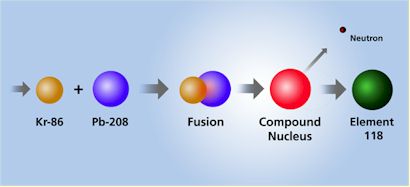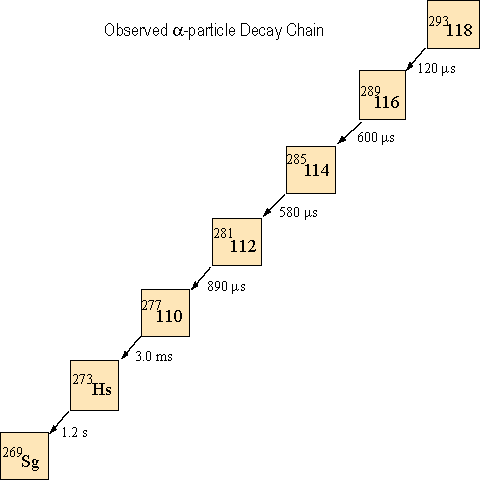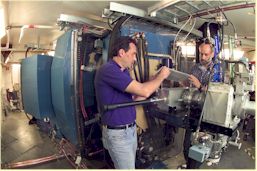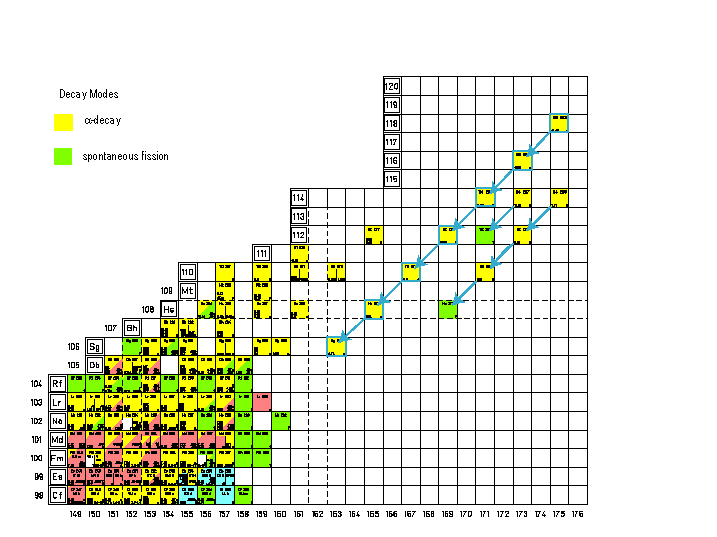
Island of stability
Element 118 synthesized
Precisely 50 years after the formulation of the nuclear shell model, the successful synthesis of the - so far - heaviest element with proton number Z = 118 has provided another totally unexpected confirmation of these ideas. This time, the event originated at the 88-Inch-cyclotron of the Lawrence Berkeley National Laboratory, rather than at GSI where one might have expected it to occur.
Element 118: Die Experimentanalyse war falsch. Die Entdeckung wird zurueckgezogen. *27. July 2001*
At the upper limit of the periodic table, the elements gain their stability solely through the quantum-mechanical ordering of the system of nucleons. Whereas these nuclei would be unstable as charged droplets, the binding is enhanced by several million electron volts due to the shell structure. Hence, the heaviest elements are relatively stable, with half-lives in the region of micro- to milliseconds, and they decay by alpha-emission rather than spontaneous fission.
On the basis of shell-model calculations, one had expected a particularly stable configuration with closed proton- and neutron shell (analogous to lead-208) at Z = 114 (due to the spin-orbit splitting of the 2f-level) and N = 184. The search for such an "island of stability" was one of the main motivations behind the establishment of GSI and the research into the synthesis of the heaviest elements, which continued earlier successful work regarding the fusion of light projectiles with transuranium elements at Berkeley and Dubna - such as the the synthesis of Dubnium (Z=105) and Seaborgium (Z=106).
Cold fusion
As the most promising reaction mechanism for the synthesis of even heavier elements, cold fusion of medium-heavy nuclei (such as iron) with heavy nuclei (such as bismuth) was proposed in Dubna in 1973, and later taken up at GSI - and now, at Berkeley. In these reactions, the excitation energy of the fused system remains low, and it cools down to its ground state by the emission of only one or two neutrons. The evaporation residues can be recognized from the kinematics and hence, can be separated from the other reaction products in a velocity filter: SHIP at GSI, BGS at LBNL.
Peter Armbruster and his colleagues at GSI - including Victor Ninov, first
author
of the now-successful collaboration at LBNL - succeeded to synthesize
deformed heavy nuclei
with proton numbers Z=107 to 112 in the years 1981 - 1996. They identified
the produced isotopes using the time-correlated alpha-decay chains
following the implantation signal in a position-sensitive silicon
detector, taking advantage of the known decays at the ends of
the chains. Elements 107 (Bohrium), 108 (Hassium), and 109 (Meitnerium)
have been named; two nuclei of element 112 with 165 neutrons were detected,
with a half-live of 280 microseconds. The cross section of 1
picobarns (10^-36 cm^2) is extremely low,
about one atom per month could be synthesized. For the production of
element 113 in the reaction zinc-70+bismuth-209, GSI could establish an
upper limit for the production cross section of 0.6 picobarns. The decay
chain indicative of successful synthesis was not observed.
The measured fusion cross sections as well as the half-lives drop
exponentially in the relatively small region of 10 proton numbers. As a
consequence, the attempt to synthesize and detect elements beyond Z=114 was
considered to be hopeless without improving the separator.

Fig.1: Synthesis of element 118 in cold fusion of krypton-86 and lead-208
Nevertheless, 15 scientists at the Lawrence Berkeley National Laboratory tried to jump directly to element 118 using cold fusion of krypton-86 and lead-208 at an incident energy of 449 MeV, and - much to their own surprise - were immediately successful. In 11 days of beam time in April and May 1999, they observed three characteristic alpha-decay chains with six subsequent alpha-decays, correlated in time and position. The analysis of the chains is consistent with the production of element 118, and with a theoretical prediction of Robert Smolanchuk that had triggered the experiment. Accordingly, the compound nucleus of Z=118 with mass number 293 is formed after emission of a single neutron, and in the subsequent alpha-decays element 116 (for the first time), 114 (its proclaimed synthesis in Dubna has not been verified), 112, 110, Hassium and Seaborgium appear, figure 2. The production cross section of 2.2 (+2.6/-0.8) picobarn is unexpectedly high: assuming the trend of exponentially decaying cross sections that was observed up to element 112 to continue, one had expected a cross section below 1 femtobarn. A similar result is found for the half-live of 120 microseconds that is determined from the measured correlation times; here, continuation of the exponential decay with increasing Z would yield a value below 1 picosecond. Evidently, the first member of the island of superheavy elements has been synthesized. If this interpretation persists, the consequence is likely that the closed proton shell expected at Z=114 is rather to be found at or near Z=120. This would be in agreement with relativistic mean-field calculations and also some phenomenological shell-model calculations which predict a depression of the central density at Z=120.

Fig.2: Decay chain of element 118 with half-lives
Gas-filled separator
Victor Ninov (figure 3) and his colleagues from LBNL and Oregon State University reached this remarkable breakthrough at LBNL's 88-Inch-Cyclotron. Although operating since 1961, this machine has been upgraded, in particular, by the addition of two high-performance ECR-ion sources for the production of high charge-state ions. It is presently the only accelerator in the US that can deliver krypton beams at the intensities that the experiment demanded: 1.9*10^12 Kr-19+ -ions per second. GSI provided nine lead-targets for the target wheel that was rotated 400 times per minute, and also the carbon entrance window of the separator.
The newly constructed helium-filled separator BGS which started operation in 1998 is the key to the success of the Berkeley group. It consists of three magnets, a vertically focussing quadrupole magnet followed by a strong horizontally focussing gradient dipole magnet and a flat dipole magnet. It allows to separate the fusion evaporation residues efficiently from other reaction products and beam particles. In the focal plane region of the separator, the residues pass through a parallel plate avalanche counter that records time, position and energy loss of the particles and serves to suppress the background of reaction products and beam particles. Afterwards, the recoils were implanted in a 300 micrometer thick silicon detector at the focal plane with an active area of 8cmx3.5cm, and their subsequent correlated alpha-decays were recorded. Two of the three decay chains of six correlated high-energy alpha-decays (more than 12 MeV in the first decay) are complete and constitute indirect proof for the synthesis of element 118. In the third chain, the first alpha-particle is not detected, probably because it occured within the 120 microseconds dead time (after recoil implantation) of the data acquisition system. The measured mean correlation times yield the half-lives shown in figure 2.

Fig.3: Victor Ninov and Ken Gregorich at work at the Berkeley gas-filled separator (BGS)
A major obstacle in the unique identification of the new elements is the fact that the decay chain leads through a region of elements or isotopes that have never been observed before: elements 118 and 116 are totally new, element 114 is not confirmed, and elements 112, 110, 108, 106 are known, but the isotopes seen in the present experiment have never before been observed. Hence, it is not yet possible to directly confirm that ^293 118 is the parent of the decay chain. However, other possibilities are energetically excluded, and the energies of the measured alpha-particles agree well with the theoretical prediction that motivated the experiment. Hence, there is little doubt that element 118 has been identified correctly.
GSI has attempted to verify the discovery using SHIP in June 1999. So far (17.06.1999) the attempt has not been successful. This may be due to the fact that the precise determination of the optimum beam energy is of crucial importance in the synthesis of heavy elements - however, an exact energy calibration of the UNILAC and 88-Inch-cyclotron accelerators is not possible. The attempt to reproduce the result continues.
A confirmation that one has reached the island of stability for the first time with the synthesis of element 118 would be the starting point for a detailed exploration of that island. Other elements and isotopes could be synthesized, and their nuclear properties be examined, starting with element 119 in the reaction krypton-86 plus bismuth-209. Of particular importance is the precise position of the closed shell - the highest mountain on the island - which should, according to the new findings, be at or near Z =120.
G.W.
 Fig.4: Extension of the periodic table via element 118 and its decay
(the decay chains of element 114 claimed by Dubna have not
been verified and are probably wrong).
Fig.4: Extension of the periodic table via element 118 and its decay
(the decay chains of element 114 claimed by Dubna have not
been verified and are probably wrong).
Source of all figures: Lawrence Berkeley National Laboratory. More information at LBNL
cf. GSI-Nachrichten 3/99 for full article.